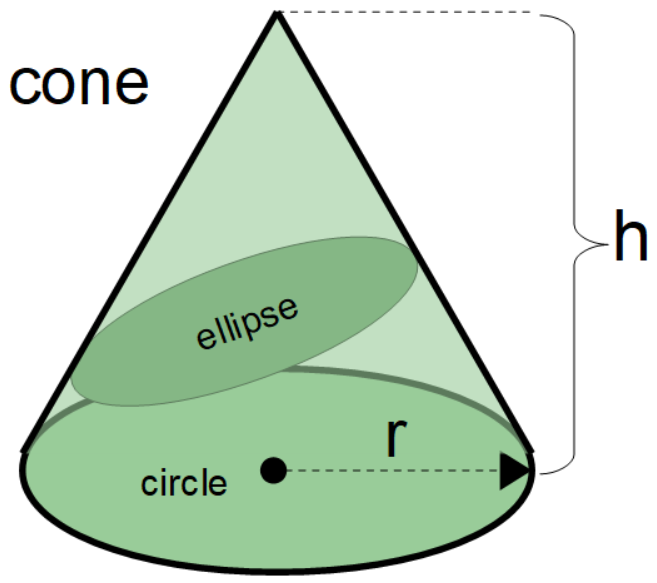Cone Frustum Height from Volume and Outer Angle
Tags | |
UUID | ab57ec6f-c134-11ef-98f1-bc764e203090 |
The Cone Frustum Height from Volume and Outer Side Angle calculator computes the height of a frustum (slice) of a cone based on the bottom radius and volume of the frustum and the angle of the side.
INSTRUCTION: Choose units and enter the following:
- (α) Outer Side Angle
- (r) Radius of Bottom
- (V) Volume of Frustum
Height of Cone Section (h): The calculator computes the height (h) and top radius (R) in centimeters (cm). However these can be automatically converted to compatible units via the pull-down menu.
The Math
The frustum is the difference of two cones where:
- the smaller cone has radius 'r' and height 'a'
- the larger cone has radius 'R' and height 'A'
and we are seeking h=A-a.
The larger cone has volume (PI/3)*A*R*R; the smaller was volume (PI/3)*a*r*r. We are given the frustum volume (V) which is the difference of the two. We are also given the angle alpha, thus we know:
- a = r * tan(alpha)
- A = R * tan(alpha)
Since we know 'r', thus we know 'a'. We can just re-write:
`V = (PI*tan(alpha)/3)*(R^3-r*r*r)
thus we can express 'R' in terms of things we know and we know 'A' is just R * tan(alpha).
The closed form for 'R' is a bit messy:
R = cube root(3*V*cot(alpha)/PI + r*r*r)
- Cone Surface Area based on cone height and cone base radius
- Cone Volume based on cone height and cone base radius
- Cone Mass or Weight as a function of the volume and mean density
- Cone Frustum Surface Area based on the two heights and two radii
- Cone Frustum Volume based on the two heights and two radii
- Cone Frustum Weight or Mass based on the cone frustum volume and mean density
- Cone Shell Volume a.k.a. hollow cone volume
- Cone Shell Mass or Weight a.k.a. hollow cone mass
- Moment of inertia of a cone shaped object based on mass and rotation axis
- Moment of inertia of a cone shaped object based on mass and distance to apex (rotation around apex)
- Compute the total surface are of the frustum of a cone: This includes the top and bottom surfaces.
- Compute the lateral surface area (using L) of the frustum of a cone.
- Cone Frustum Volume from Angle
- Cone Frustum Height from Volume and Outer Side Angle: Computes height based on volume, small radius and outer side angle.
- Cone Frustum Height from Volume and Inner Side Angle: Computes height based on volume, small radius and inner side angle.
Volume is a three dimensional measurement of the amount of space taken up by an object. Volume units are cubic measurements for solid objects such as cubic inches and cubic meters. Fluids have separate volume units such as liters, fluid ounces, cups, gallons, and barrel.
The volume of an object can measured by the liquid it displaces or be calculated by measuring its dimensions and applying those dimensions to a formula describing its shape. Many such calculations are available in the following list of calculators.
In many cases, the calculators are for a column with a geometric shaped base and vertical sides. One basic formula for volume is area times a Height when the volume has vertical sides.

Volume Calculators
- Volume from Area and Height
- Volume of a Cube
- Volume of a Box
- Volume of a Cone
- Volume of a Cone Frustum
- Volume of a Cylinder
- Volume of a Slanted Cylinder
- Volume of a Semicircle
- Volume of a Triangular
- Volume of a Quadrilateral
- Volume of a Pentagon
- Volume of a Hexagon
- Volume of a Heptagon
- Volume of a Octagon
- Volume of a Nonagon
- Volume of a Decagon
- Volume of a Hendecagon
- Volume of a Dodecagon
- Volume of a Paraboloid
- Volume of a Polygon based Pyramid
- Volume of a Pyramid Frustum
- Volume of a Sphere
- Volume of a Sphere Cap
- Volume of a Sphere Segment
- Volume of a Sphere Shell
- Volume of a Oblate Spheroid
- Volume of a Ellipsoid
- Volume of a Torus
- Volume of a Bottle
- Volume of a Chamfer
- Gasket Volume
- Comments
- Attachments
- Stats
No comments |


